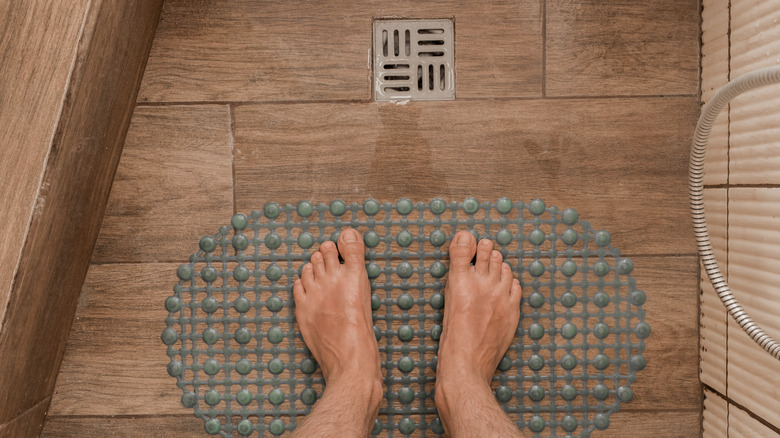How To Choose The Best Shower Drain For Your Bathroom Design
Shower drains might not be high on your list of priorities when you design or renovate your bathroom. Yet, picking the right one is important to prevent the dirty water accumulating after each of your baths. But how do you choose the best shower drain for your bathroom among varied options, like point, linear, and tile insert drains? To help you make the right decision, House Digest spoke exclusively with Chuck Pound, virtual plumbing expert at Frontdoor. Shedding light on the most basic kind, he says, "Shower point drains are round or square shaped drains that are usually installed in the center of the shower floor." However, they aren't as pretty as their counterparts and might not be the right choice for you if you want your master bathroom to feel like a luxury oasis.
Talking about the second option, Pound mentions, "On the other hand, linear drains are long and narrow and are usually installed along a wall inside the shower." Unfortunately, you'll have to clean them often to maintain their sleek look. In other words, these types of drains might not be a good fit if you want something low-maintenance. Elaborating on the final kind, he explains, "Another type of shower drain option to consider are tile insert drains, designed to blend with tile or other flooring materials." Although they're the prettiest of the lot, they get jammed more easily than the others. So, you must learn to unclog them. In case this seems like too much work, steer clear of them. That being said, carefully consider the pros and cons of each drain type before installing one in your bathroom.
The pros and cons of each shower drain type
Point or center shower drains are common fixtures and have a lot going for them. They're known for their cost-effectiveness and ease of cleaning. Plus, they're simple to install and you don't necessarily need a professional if you're an experienced DIYer. On the flip side, they only work with small floor tiles since the floor needs to slope in all directions to form a cup-like shape. This is also why they don't work well with curbless designs. Additionally, they aren't the best looking. Pound agrees in his exclusive interview with House Digest: "These drains are easier to install than linear drains but can seem somewhat basic in a custom-style shower."
Comparatively, linear drains look gorgeous. They work well with large tiles since they're installed against a wall and don't need a sloped surface on all sides. You should consider a linear shower drain for optimal drainage because they can handle water flow at a higher rate like that from a rainfall showerhead, handheld faucet, or body jets. Highlighting their pros and cons, he says, "These drains offer more drainage capacity for larger showers; however, they do cost more than standard point drains." This is mainly because they're bigger than point drains and you need to contract a professional to install and waterproof them.
"A tile insert shower drain ... helps the drain blend into the shower floor is a decorative way to blend the drain into the shower floor," Pound says. "While tile insert shower drains are not 100% invisible, they do allow for a beautiful, decorative look." Alas, they require professional installation, regular cleaning, and clog easily.
How to pick the right shower drain for your bathroom
To ensure you pick the right shower drain for your bathroom, Pound lists a few factors you should consider in his House Digest exclusive. "First, you should measure the inside of the shower floor, then decide on the most practical location based on the floor's slope or space for slope," he says. "If the location is not ideal for your plans or not near the center of your shower floor, consider a linear drain against a wall." This means if you don't have a floor that naturally slopes on all four sides, point shower drains are out of the question. While linear ones would make the most sense in such scenarios, you can also opt for tile inserts if you want a seamless finish.
Moreover, consider each drain type's maintenance requirements. Since shower drains are one of the grossest things professional house cleaners have encountered in their line of duty, pick one that you can realistically clean and maintain. As for the style and finish of the shower drain, Pound suggests, "When picking the shape and finish of your drain, I'd suggest matching the shape of the shower trim. If your trim plate and shower head for the shower valve are both square, for example, you would want a square drain to match it in most cases." Further, only opt for stainless steel as they last longer than PVC and don't require as much upkeep as brass and bronze. You should also consider your water drainage needs. If you enjoy long baths or have high water pressure, linear drains would be the best choice.


